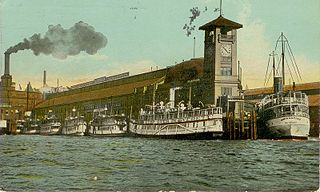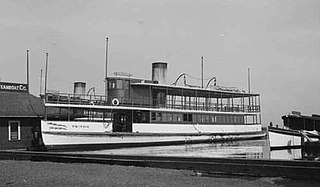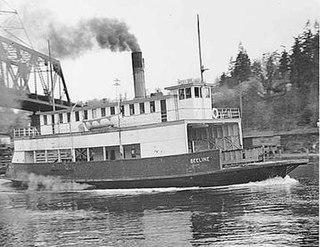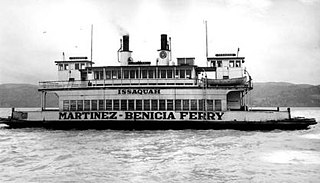
The Puget Sound mosquito fleet was a multitude of private transportation companies running smaller passenger and freight boats on Puget Sound and nearby waterways and rivers. This large group of steamers and sternwheelers plied the waters of Puget Sound, stopping at every waterfront dock. The historical period defining the beginning and end of the mosquito fleet is ambiguous, but the peak of activity occurred between the First and Second World Wars.

Lake Washington steamboats and ferries operated from about 1875 to 1951, transporting passengers, vehicles and freight across Lake Washington, a large lake to the east of Seattle, Washington. Before modern highways and bridges were built, the only means of crossing the lake, other than the traditional canoe or rowboat, was by steamboat, and, later, by ferry. While there was no easily navigable connection to Puget Sound, the Lake Washington Ship Canal now connects Lake Washington to Lake Union, and from there Puget Sound is reached by way of the Hiram M. Chittenden Locks.

The steamboat Triton was a passenger ferry that operated on Lake Washington in the first part of the 20th century.

The steamboat Fortuna was a vessel that operated on Lake Washington in the first part of the 20th century.

The steamboat Defiance operated in the early 1900s as part of the Puget Sound Mosquito Fleet. In later years this vessel was called Kingston.

The steamboat Monticello (2) operated in the early 1900s as part of the Puget Sound Mosquito Fleet. The vessel went through several reconstructions and remained in service until 1962, when she was lost in Alaska waters. Her later names were Penaco and Sea Venture. (This Puget Sound steamer should not be confused with the smaller Monticello, which also ran on Puget Sound, but was built in 1895 for Captain Z.J. Hatch of the Monticello Steamship Company.

The Seattle–Bremerton ferry is a ferry route across Puget Sound between Seattle and Bremerton, Washington. Since 1951, the route has primarily been operated by the state-run Washington State Ferries system, currently the largest ferry system in the United States. Kitsap Transit also runs passenger-only "fast ferries" service on the route.
The Kitsap County Transportation Company was an important steamboat and ferry company that operated on Puget Sound. The company was founded in 1898 as the Hansen Transportation Company.

Lady of the Lake was a wooden steamboat that operated on Puget Sound from 1897 to 1903. Following a fire in 1903, the vessel was rebuilt as the tug Ruth.

Florence K was a steamboat that was operated on Puget Sound from 1903. This vessel was later renamed Gloria and was rebuilt as a steam ferry and renamed Beeline.

Inland Flyer was a passenger steamboat that ran on Puget Sound from 1898 to 1916. From 1910 to 1916 this vessel was known as the Mohawk. The vessel is notable as the first steamer on Puget Sound to use oil fuel. Inland Flyer was one of the most famous vessels of the time on Puget Sound.

West Seattle was a side-wheel driven steam-powered ferry built in 1907.

Issaquah was a steam ferry built in 1914 that operated on Lake Washington and in San Francisco Bay.

King County was a steam ferry built in 1900 which served on Lake Washington until 1908.

Atlanta was a steamboat built in 1908 at Houghton, Washington which served on Lake Washington and Puget Sound until 1938, when it was converted into a diesel-powered houseboat.

Suquamish, built in 1914, was the first diesel-engined passenger vessel in the United States. Much later Suquamish was converted to a commercial fishing vessel and was registered as a Canadian vessel under the name Terry.

Speeder was a motor launch built in 1908 which served on Puget Sound and in the San Juan Islands. From 1908 to 1922 this vessel was named Bainbridge.

The steamboat Acme operated on Lake Washington and also on the Sammamish Slough to Bothell, Washington from 1899 to 1910, when it was destroyed by fire.

Falcon was a 26 registered ton gasoline-powered launch built in Bellingham, Washington in 1909. She operated in Puget Sound and nearby regions, and also on Lake Washington during the first part of the 1900s. The wreck of this vessel has been discovered in Lake Washington not far from Kirkland and is in good condition under 190 feet (58 m) of water. This vessel should not be confused with the steam tug Falcon built in Tacoma, Washington in 1902.

Captain John Laurentius Anderson was a preeminent figure in Washington state maritime industries in the first half of the twentieth century, particularly ferry service, shipbuilding, and ship-based tourism. He ran the largest ferry fleet on Lake Washington for three decades. He ran a large ferry fleet in Puget Sound. He built more than a dozen vessels at his shipyards, including the first ocean-going ship ever built on Lake Washington.
This page is based on this
Wikipedia article Text is available under the
CC BY-SA 4.0 license; additional terms may apply.
Images, videos and audio are available under their respective licenses.



















